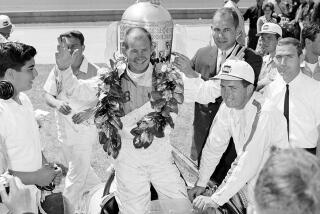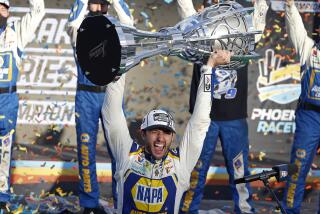TAKING THE CHECKERED FLAG
- Share via
INDIANAPOLIS — I’ve never met John Elway, Wayne Gretzky or Michael Jordan, but I’m certain I’m feeling the same emotions they were earlier this year when they decided to retire.
It’s a difficult process, because it means walking away from the only way of life you’ve ever known. Talking with family and friends can help. One of the most useful conversations I had was with Rick Mears, who retired seven years ago after four Indianapolis 500 wins.
But ultimately you have to be the one to confront yourself, be honest with yourself and make that hard choice.
Once you’ve done that, however, it’s a very liberating experience.
My first thoughts of stepping out of the cockpit actually came several years ago.
I once told my wife, Mieke, “If I win Indy again, I’ll retire.” Well, I won the 500 for the second time in 1997, but I knew I wasn’t ready to stop and had to tell her, “Sorry, but . . . “
Racing does take a toll on your family life. Even when I’m not actually driving, I’m traveling, testing, attending meetings, making appearances for Sprint PCS and other sponsors, working out to stay in shape, and generally concentrating on the overall business of racing.
It’s a virtual year-round activity, and that means sometimes you’re not there for your child’s birthday or other special occasions.
For example, Arie Jr., my 17-year-old son, has started racing in the development classes, and I want to have the time to spend with him. Over the years, I’ve found myself thinking about these things more and more.
When you come right down to it, this is a sport where a driver is constantly weighing the risk vs. the reward. I’ve always been comfortable with that, but in the last 18 months, I’ve been caught up in three major accidents caused by the mistakes of other drivers. Luckily, I wasn’t seriously hurt.
Those incidents haven’t made me question my own ability or lose confidence, but they have reinforced the fact that sometimes things happen on the racetrack that you can’t control. That’s a driver’s ultimate fear.
Mears had an accident during practice at Indianapolis in the early 1990s, caused by a mechanical failure, which caused him to slide upside-down on the back straightaway.
Fortunately, he wasn’t seriously injured, but he later said his thoughts while sliding on his head were, “I don’t need this anymore.”
Not surprisingly, Rick retired several months later.
Over time, those kind of thoughts have come to me, and that risk vs. reward ratio started to tip in the wrong direction. However, I didn’t feel I could stop cold turkey.
After I won the last race of the 1998 IRL season, in Las Vegas, I spoke with Fred Treadway, who not only is my team owner but also a good friend. He knew what was coming, and agreed to field a first-class car for me at Indianapolis. Fred knows my motivation to do the job remains high.
Normally, I don’t care to do a lot of tire testing, but I made sure to participate in a Firestone test at the speedway last month. I immediately felt comfortable in the car and my lap speed of over 224 mph was one of the fastest in the test, so I have every reason to be confident both the team and I will be competitive.
Even though I grew up in the sport as a road racer, people know me for winning the Indianapolis 500. So, we’ve created a program known as “Arie’s Final 500” that includes many public autograph sessions, charity events, and other appearances where I can meet a lot of the fans this month and thank them for their support over the years.
I’ve always said the fans are part of the racing family, like the crew members and officials, and I want to go out by letting everyone who has helped me know how much I appreciate them.
The Super Bowl provided the perfect stage for John Elway to bid farewell. Indianapolis does that for me.
More to Read
Go beyond the scoreboard
Get the latest on L.A.'s teams in the daily Sports Report newsletter.
You may occasionally receive promotional content from the Los Angeles Times.










